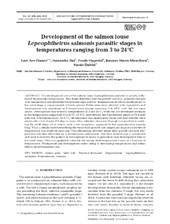| dc.contributor.author | Hamre, Lars Are | |
| dc.contributor.author | Bui, Samantha | |
| dc.contributor.author | Oppedal, Frode | |
| dc.contributor.author | Skern-Mauritzen, Rasmus | |
| dc.contributor.author | Dalvin, Sussie | |
| dc.date.accessioned | 2019-11-08T16:42:57Z | |
| dc.date.available | 2019-11-08T16:42:57Z | |
| dc.date.issued | 2019-09-05 | |
| dc.Published | Hamre LA, Bui S, Oppedal F, Skern-Mauritzen R, Dalvin ST. Development of the salmon louse Lepeophtheirus salmonis parasitic stages in temperatures ranging from 3 to 24°C. Aquaculture Environment Interactions. 2019;11:429-443 | eng |
| dc.identifier.issn | 1869-215X | en_US |
| dc.identifier.issn | 1869-7534 | en_US |
| dc.identifier.uri | http://hdl.handle.net/1956/20967 | |
| dc.description.abstract | The development rate of the salmon louse Lepeophtheirus salmonis is greatly influenced by seawater temperature. This study describes how the growth rate of L. salmonis changes with temperature and identifies the extreme high and low temperatures at which development to the adult stage is compromised. Atlantic salmon Salmo salar were infected with copepodids and development was monitored in 8 temperature groups spanning 3 to 24°C until the lice were adults. Development was severely compromised at 3 and 24°C, while the lice developed normally in the temperature range from 6 to 21°C. At 6°C, most female lice had become adults at 72 d post infection (432 degree-days). At 21°C, development was significantly faster and most females were adults after 13 d, at only 271 degree-days. After infection, lice grew through 5 stages before reaching the adult stage, all of which, with a few exceptions, appeared to last approximately equally long. Thus, a simple model describing the mean daily growth rate (stages per day) as a function of temperature was made for each sex. The relationship between mean daily growth rate and temperature was best described by a second-order polynomial. The term relative age is introduced and used to describe the pattern of development in terms of percent of total development time to the adult stage. This was applied to calculate the timing of developmental events as a function of temperature. Photoperiod and development under rising or decreasing temperatures had minor effects on development rate. | en_US |
| dc.language.iso | eng | eng |
| dc.publisher | Inter-Research | en_US |
| dc.rights | Attribution CC BY | eng |
| dc.rights.uri | http://creativecommons.org/licenses/by/4.0/ | eng |
| dc.subject | Salmo Salar | eng |
| dc.subject | Molt rate | eng |
| dc.subject | Thermal tolerance | eng |
| dc.subject | Reproduction | eng |
| dc.subject | Lepeophtheirus salmonis | eng |
| dc.subject | Poikilotherm | eng |
| dc.subject | Ecdysis | eng |
| dc.title | Development of the salmon louse Lepeophtheirus salmonis parasitic stages in temperatures ranging from 3 to 24°C | en_US |
| dc.type | Peer reviewed | |
| dc.type | Journal article | |
| dc.date.updated | 2019-09-20T11:50:12Z | |
| dc.description.version | publishedVersion | en_US |
| dc.rights.holder | Copyright The Author(s) 2019 | en_US |
| dc.identifier.doi | https://doi.org/10.3354/aei00320 | |
| dc.identifier.cristin | 1725510 | |
| dc.source.journal | Aquaculture Environment Interactions | |
| dc.relation.project | Norges forskningsråd: 294730 | |
| dc.relation.project | Fiskeri- og havbruksnæringens forskningsfond: 901283 | |

